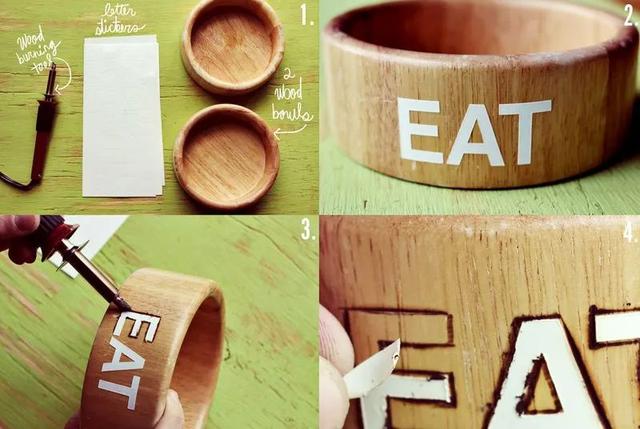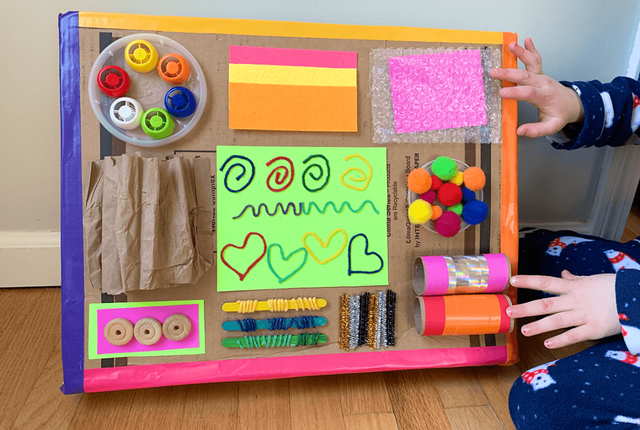【往期回顾】
【本期内容】
A brief history of DIY
DIY的发展简史

DIY is an abbreviation of the phrase Do It Yourself. DIY was a term that emerged in the late 1950s and early 1960s. The term originally referred to a type of woodworking but soon became associated with home improvement and gardening.
DIY是短语Do It Yourself的缩写。DIY是一个出现在20世纪50年代末和60年代初的术语。这个词最初指的是一种木工,但很快就与家庭装修和园艺联系在一起。
As a result, DIY means different things to different people. For some, it is about making things with your own hands and learning new skills in the process. For others, it’s about being able to do what you want without relying on anyone else or being forced into something you don’t want to do; for some, it’s about being able to create something that would otherwise not exist at all.
因此,DIY对不同的人来说意味着不同的东西。对一些人来说,这是关于用自己的双手制作东西,并在这个过程中学习新技能。对其他人来说,这是关于能够做你想做的事,而不依赖其他人,或者被迫做你不想做的事情;对一些人来说,这是关于能够创造一些原本根本不存在的东西。
The history of this word is quite interesting, and it is not always clear what it means because there are many definitions for it.
这个词的历史很有趣,但并不总是清楚它具体什么含义,因为关于它有很多定义。

A Pre-History Of DIY
DIY的前史
Taking care of practical work at home was a long-held interest long before the DIY movement of the 20th century. Modern DIY manuals owe their existence to Joseph Moxon’s book Mechanick Exercises. This book discussed engravery, printing books, making maps, making mathematical instruments, and being a blacksmith. It was published between 1683 and 1685.
早在20世纪的DIY运动之前,在家动手干活就已经是一种长期存在的兴趣。现代DIY手册的存在归功于约瑟夫·莫克森的《技工实操》一书。这本书讨论了雕刻、印刷书籍、制作地图、制作数学仪器和打铁。它出版于1683年至1685年之间。
Before the car was invented, people who wanted to play with machines usually bought a lathe. Due to their high price, they were usually owned by the wealthy. As well as the basic lathes, Holtzapffel of London produced a whole range of accessories for increasingly complex projects. However, our modern eyes might find the finished products a little too decorative.
在汽车发明之前,想玩机器的人通常会买一台车床。由于价格高昂,它们通常归富人所有。除了基本的车床,伦敦的霍尔扎菲尔公司还为日益复杂的项目生产了一系列配件。然而,我们现代人的眼睛可能会发现成品有点过于花俏。
DIY Magazines
DIY杂志
During the first half of the twentieth century, DIY magazines were popular in North America. It was initially geared toward rural and semi-rural readers, as many lived on farms or in small towns. Readers of magazines like Popular Mechanics (founded in 1902) and Mechanix Illustrated (founded in 1928) could stay up-to-date on practical skills, techniques, tools, and materials through these publications.
在二十世纪上半叶,DIY杂志在北美很流行。它最初面向农村和半农村读者,因为许多人住在农场或小城镇。《大众力学》(1902年创刊)和《机械画报》(1928年创办)等杂志的读者可以通过这些出版物了解最新的实用技能、技术、工具和材料。

In 19th-Century
19世纪
The moral incentive to help yourself was strong in 19th-century society. The manual ‘Self Help; With Illustrations of Character and Conduct’ written by Samuel Smiles in 1859 became a bestseller. Learning was described as one of life’s greatest pleasures, and it was a person’s responsibility to educate himself or herself rather than rely on others to do so. With time, the workplace philosophy spread to the home, and ‘productive leisure’ began to take off. For many people, however, doing things for themselves was a necessity rather than a luxury. A large number of extra children were born during the 19th century as a result of a population explosion. Making toys at home was cheaper than buying them, which led to a long-lasting trend.
在19世纪的社会中,自己动手的道德动机是强烈的。塞缪尔·斯迈尔斯于1859年创作的手册《自己动手;配有人物与行为插图》成为畅销书。学习被描述为生活中最大的乐趣之一,教育自己而不是依赖他人是一个人的责任。随着时间的推移,职场哲学传播到了家庭,“生产性休闲”开始兴起。然而,对许多人来说,为自己做事是必需品,而不是奢侈品。19世纪,由于人口激增,大量额外的孩子出生了。在家制作玩具比购买便宜,这导致了一种长期的趋势。
The Victorian Age
维多利亚时代
Let’s take a trip back to Victorian times. Women were the original DIYers around the home during the Victorian Arts and Crafts movement. As for home repair, those tasks were usually hired out or handled by servants, but women made a lot of decorative products. As a matter of fact, civilized Victorians and true gentlemen would never engage in such menial labor. It is estimated that only 10% of men worked for someone other than their families before 1870.
让我们回到维多利亚时代。在维多利亚工艺美术运动期间,妇女是家里最初的DIY能手。至于家庭维修,这些任务通常由仆人雇佣外人或自己处理,但女性制作了许多装饰产品。事实上,文明的维多利亚人和真正的绅士永远不会从事这种卑微的劳动。据估计,在1870年之前,只有10%的男性为家人以外的人工作。
Does anyone want to complete their “job” for the day and then continue working? In magazines like Popular Science (published in 1872) and Popular Mechanics (1902), however, plans for “labor saver” contraptions were being published that one could build to assist with household tasks.
有人想完成当天的“工作”,然后继续干活吗?然而,在《大众科学》(1872年出版)和《大众技工》(1902年)等杂志上,人们正在发布“节省劳动力”的装置计划,人们可以建造这些装置来帮助完成家务。

On To The 1920s
到20世纪20年代
Approximately two-thirds of American men worked outside the home at this time. This number only increased after the Great Depression. It was in 1931 that C.T. Schaefer wrote the first book on how to maintain a house. Because of the 1938 Fair Labor Standards Act, men had more leisure time since 40 hours a week was the maximum. At this early age, the term “Do-it-Yourself” was first used, although it was not widely known.
大约三分之二的美国男性此时在家外工作。这个数字在大萧条之后才有所增加。1931年,C.T.谢弗写了第一本关于如何维护房子的书。由于1938年的《公平劳动标准法》,男性有更多的空闲时间,因为每周最多40小时。在这么早的年代,“自己动手”这个词就首次被使用,尽管它并不广为人知。
The how-to manual “Make it Yourself” by Julian Starr was published in the 1940s and grew so popular that Starr began writing a weekend column on the subject.
朱利安·斯塔尔的操作手册《自己动手》出版于20世纪40年代,大受欢迎,斯塔尔开始关于主题的周末专栏写作。
DuPont In 1941
杜邦1941
It took a while for the do-it-yourself movement to gain traction. A DuPont showroom brochure, for example, showed a typical 1940s house and rooms. In the brochure, DuPont used its new cellophane technology to produce overlays of how other DuPont paint colors might look on the house and rooms. In addition, the DuPont materials discouraged homeowners from undertaking such a task, encouraging them to hire professional painters. It is estimated that only one-third of Americans painted their own homes before 1950. By the 1950s, that figure had risen to 80%.
自己动手的运动需要一段时间才能获得吸引力。例如,杜邦公司的展厅小册子展示了一栋典型的20世纪40年代的房子和房间。在小册子中,杜邦公司使用其新的玻璃纸技术制作了其他杜邦油漆颜色在房屋和房间上的覆盖物。此外,杜邦材料不鼓励房主承担这样的任务,鼓励他们雇佣专业画家。据估计,只有三分之一的美国人在1950年之前粉刷过自己的房子。到20世纪50年代,这一数字已经上升到80%。

By The 1950s
到20世纪50年代
As people began constructing homes, undertaking construction projects, and creating smaller crafts in the 1950s, DIY was becoming more popular. In order to oppose mass production and mass culture, artists began claiming to be self-made. A homemade Cold War nuclear fallout shelter was one example of DIY practices responding to geopolitical tensions.
20世纪50年代,随着人们开始建造房屋、进行建筑项目和创作较小的工艺品,DIY变得越来越流行。为了反对大众生产和大众文化,艺术家们开始声称自己是白手起家的。自制的冷战核沉降物避难所是应对地缘政治紧张局势的DIY做法的一个例子。
In The 1950s, The “Do-It-Yourself” Movement Rose To Prominence
20世纪50年代,“自己动手”运动兴起
It may seem strange to some people that we specialize in products for mid-century buildings rather than producing “complete” products for people. During the 1950s, when our products were in their heyday, we firmly believed in the Do-it-Yourself movement. There was a time when DIY hobbies were believed to offer psychological therapeutic benefits. Putting something you’ve built yourself into your home and using it is unforgettable.
有些人可能觉得奇怪,我们专门为世纪中期的建筑生产产品,而不是为人们生产“完整”的产品。在20世纪50年代,当我们的产品处于鼎盛时期时,我们坚信自己动手运动。曾经有一段时间,人们认为DIY爱好可以提供心理治疗益处。把你自己建造的东西放在家里并使用它是令人难忘的。
In The 1960s And 1970s
20世纪60年代和70年代
The DIY movement and techniques for building and decorating homes began to appear in books and TV shows in the 1960s and 1970s.
20世纪60年代和70年代,DIY运动以及建造和装饰房屋的技术开始出现在书籍和电视节目中。

By the 1990s
到20世纪90年代
During the 1990s, when the internet was still in its infancy, the DIY movement began to feel the impact of the digital age. As computers and the internet become more widely used, more households are taking advantage of DIY methods due to increased accessibility to the internet.
在20世纪90年代,当互联网还处于起步阶段时,DIY运动开始感受到数字时代的影响。随着计算机和互联网的广泛使用,由于互联网的可访问性增加,越来越多的家庭正在利用DIY方法。
Present Day
今天
YouTube, Instagram, and other platforms enable people to showcase their creations and teach others how to replicate DIY techniques.
YouTube、Instagram和其他平台使人们能够展示自己的创作,并教他人如何复制DIY技术。
The Bottom Line
底线
In addition to magazines and television, DIY-focused informational websites are now widely available through most mainstream media outlets. Also growing is the number of independent DIY resources available online.
除了杂志和电视,现在大多数主流媒体都可以广泛使用以DIY为重点的信息网站。在线独立DIY资源的数量也在增长。
Despite its reputation as a predominantly male activity, DIY was founded in the 1950s on broad foundations. Women and men often worked together in advertisements from the period, though men tended toward jobs like sanding and woodworking, and women made curtains or soft furnishings. The overall result was that husbands were brought back into the home from pubs and other ‘male’ pursuits, allowing them to spend more time with their families.
尽管DIY以男性为主而闻名,但它成立于20世纪50年代,基础广泛。从那个时期起,女性和男性经常在广告中合作,尽管男性倾向于从事砂光和木工等工作,女性则制作窗帘或软家具。总体结果是,丈夫们从酒吧和其他“男性”活动中被带回了家,让他们有更多的时间与家人在一起。
Aside from encouraging close bonds between fathers and children, DIY hobbies like railway modeling also brought together parents and children, which heavy workloads and wartime displacement had previously severed.
除了鼓励父亲和孩子之间建立紧密的联系外,铁路建模等DIY爱好还将父母和孩子聚集在一起,而繁重的工作量和战时的流离失所此前已经切断了这一联系。

【Source】www.gofulldiy.com
【Translated by】Spark Liao (廖怀宝)
【Illustration】From Bing
